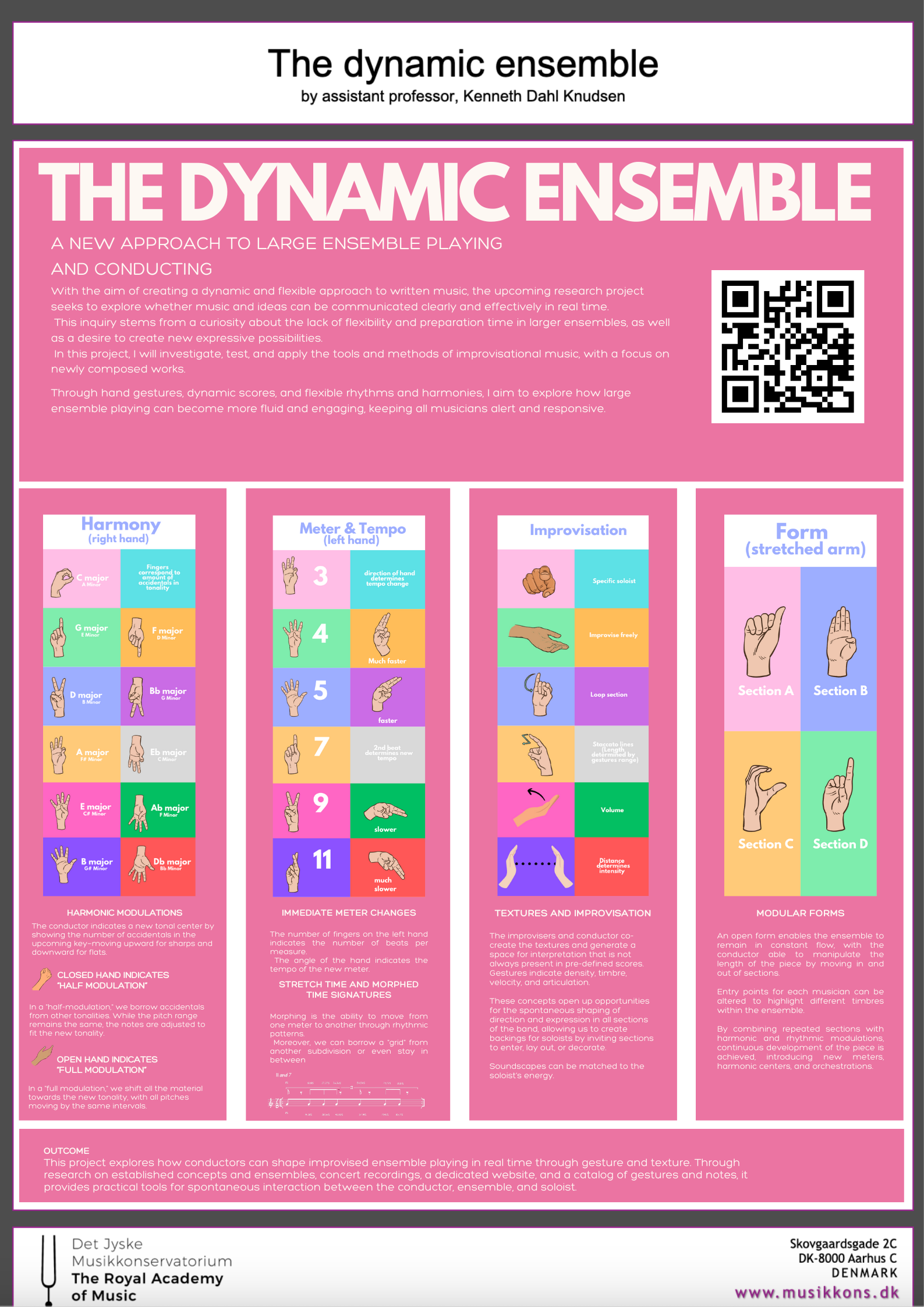Research at RAMA
The dynamic ensemble
A new approach to large ensemble playing and conducting
Through hand gestures, dynamic scores, and flexible rhythms and harmonies, I aim to explore how large ensemble playing can become more fluid and engaging, keeping all musicians alert and responsive.
With the aim of creating a dynamic and flexible approach to written music, the upcoming research project seeks to explore whether music and ideas can be communicated clearly and effectively in real time.
This inquiry stems from a curiosity about the lack of flexibility and preparation time in larger ensembles, as well as a desire to create new expressive possibilities.
In this project, I will investigate, test, and apply the tools and methods of improvisational music, with a focus on newly composed works.
MODULAR FORMS
An open form enables the ensemble to remain in constant flow, with the conductor able to manipulate the length of the piece by moving in and out of sections.
Entry points for each musician can be altered to highlight different timbres within the ensemble.
By combining repeated sections with harmonic and rhythmic modulations, continuous development of the piece is achieved, introducing new meters, harmonic centers, and orchestrations.
IMMEDIATE METER CHANGES
The number of fingers on the left hand indicates the number of beats per measure.
The angle of the hand indicates the tempo of the new meter.
STRETCH TIME AND MORPHED TIME SIGNATURES
Morphing is the ability to move from one meter to another through rhythmic patterns.
Moreover, we can borrow a “grid” from another subdivision or even stay in between
CLOSED HAND INDICATES
“HALF MODULATION”
In a “half-modulation,” we borrow accidentals from other tonalities. While the pitch range remains the same, the notes are adjusted to fit the new tonality.
OPEN HAND INDICATES
“FULL MODULATION”
In a “full modulation,” we shift all the material towards the new tonality, with all pitches moving by the same intervals.
HARMONIC MODULATIONS
The improvisers and conductor co-create the textures and generate a space for interpretation that is not always present in pre-defined scores.
Gestures indicate density, timbre, velocity, and articulation.
These concepts open up opportunities for the spontaneous shaping of direction and expression in all sections of the band, allowing us to create backings for soloists by inviting sections to enter, lay out, or decorate.
Soundscapes can be matched to the soloist’s energy.
In February 2024 I worked with the students at Fullerton university in California US.
TEXTURES AND IMPROVISATION
The conductor indicates a new tonal center by showing the number of accidentals in the upcoming key—moving upward for sharps and downward for flats.
Snippet from live concert in Kolding with the ensemble.
“Blindhæd” by Moritz Christiansen
OUTCOME
This project explores how conductors can shape improvised ensemble playing in real time through gesture and texture. Through research on established concepts and ensembles, concert recordings, a dedicated website, and a catalog of gestures and notes, it provides practical tools for spontaneous interaction between the conductor, ensemble, and soloist.
Students at RAMA morphing between 4/4 and 11/8
Results and Discussion
The preliminary outcomes suggest that large ensembles can be guided effectively through non-verbal, gestural systems that provide both clarity and openness. The conductor assumes a dual role: transmitting structural information while also shaping texture and energy in direct dialogue with the ensemble and soloists. This creates a space where improvisers contribute actively to the collective sound, and where ensemble backings and soundscapes can adapt spontaneously to the musical moment.
The project also reveals a productive tension between notation and improvisation. While the score provides a framework for harmonic and rhythmic material, the real-time application of gestures fosters variability, responsiveness, and co-creation not typically present in fixed ensemble formats.
Conclusion
By integrating improvisational methods, modular forms, and gesture-based communication, the Dynamic Ensemble project develops a framework for large ensemble playing that emphasizes flexibility and immediacy. The research contributes to ongoing discussions of how notation, conduction, and improvisation can intersect, and proposes practical tools for expanding the expressive and structural possibilities of ensemble performance in the 21st century.
Practical Applications
The concepts developed in this project have been tested in a range of ensemble settings, providing insight into their adaptability and effectiveness. Initial experiments were carried out with The Elastic Ensemble at the Royal Academy of Music in Aalborg (DJM), where students and professional musicians engaged with the gesture-based system and modular forms.
Further applications took place with the Aalborg Youth Jazz Orchestra, which demonstrated how large jazz ensembles could integrate improvisational flexibility into their established rehearsal and performance practices.
Finally, the concepts were tested internationally at California State University, Fullerton (Los Angeles), where music students explored the methods in a North American educational context. These sessions confirmed the potential of the approach to function across cultural and institutional boundaries, while also highlighting the need for clear gestural vocabulary and rehearsal strategies.



